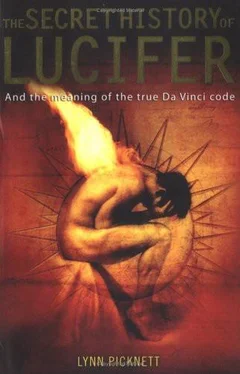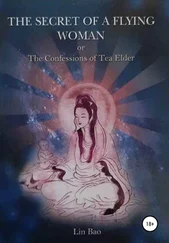The Shroud of Turin was quite clearly a substitute for an earlier alleged relic, an embarrassingly obvious painted daub on display in France in the second half of the fourteenth century, which even the local bishop disowned and named the artist involved.27 On the other hand, no one could accuse Leonardo's later version of being a blatant painted fake: a projected, photographic image had no need of paint.
Even if, as Clive and I believe, the Renaissance Maestro had been commissioned to create this crowd-pulling relic by the Vatican itself," the task he had set himself was not without its dangers. Leonardo had to approach this project with even greater than usual secrecy (although by nature an intensely private man): it would not have been wise to make public the method he used to create a non-painted image, thought by many to be sorcery. In fact it seems he employed a camera obscura or pinhole camera - which he called the oculus artificialis, the artificial eye - described in his notebooks in the following terms:
If the facade of a building, or a place, or a landscape is illuminated by the sun and a small hole drilled in a building facing this, which is not directly lighted by the sun, then all objects illuminated by the sun will send their images through this aperture and will appear, upside down, on the wall facing the hole.29
Leonardo was constantly in danger even experimenting with a simple pinhole camera: the Church reserved a special antipathy towards what we would recognize as the early experiments in photography, perhaps because it saw the capturing of a lifelike image without brushes and paint as demonic. It must have seemed like magic: it was not merely the `primitive' peoples who believed that to take someone's photograph was bad luck, for it stole the soul. To the medieval and Renaissance authorities it really did seem as if the new science threatened to `catch' every nuance of the living being, as if a vital essence had been waylaid by the sorcerer/photographer. As demons notoriously stole souls, why were photographers any different? A lifelike photograph was indeed a magical image, even a sort of graphic version of the demonic pact - the soul frozen in time, captured and possessed.
Even a generation after Leonardo, his fellow countryman Giovanni Battista della Porta was arrested for sorcery after demonstrating a magic lantern by projecting the images of actors onto a wall."0 However, in della Porta's case, the evidence was already stacked against him: he was a known Hermeticist and alchemist, and founder of the Academy of Secrets, which was disbanded by the Vatican. He managed to extricate himself from jail, but only with the greatest effort - it was a near thing.
To the photographer/alchemist himself the very concept of capturing living images must have seemed magical, and the actual process even more so. In discussing the `Picatrix' or Ghayat al Hikam, The Aim of the Wise, the Arabic book of astrological and magical aphorisms dating from around 1000 CE, Tobias Churton writes:
Picatrix maintains that the whole art of magic consists in `capturing' and guiding the influence of spiritus (something like the souls of the celestial world, below intellectus, or the Greek nous) into materia. The method consisted in making talismans: images associated with the stars, inscribed on the correct materials at the most propitious times (astrology played a part), and in the right state of mind.* The practice demanded a deep knowledge of astronomy, mathematics, music and metaphysics, and formed a kind of mirror to the practice of alchemy. Talismanic magic aimed to get spiritus into material form, while alchemy aimed at extracting spiritus from matter in order to change the matter and the mind of the operator.31
Churton also adds as a note (to * above): `Perhaps the conceptual origin of Photography: `light-writing', from the Greek photos=light and graphe=writing; making an impression.'32 Is the Shroud of Turin actually a magical talisman, imbued with the DNA, not of the Son of God, but of the pretender to the rank of Grandson of God? There is real blood on the Shroud, after all, although it may be a mixture of Leonardo's and of certain chosen others. (There is even a suggestion of female DNA33 on the image, which would be in keeping with the artist-photographer's obsession with the Gnostic/alchemical androgyne. This can also be seen in Leonardo's sketch `Witch with a Magic Mirror', which at first glance simply shows a young woman admiring herself in a hand mirror. But look carefully and you will see that the back of her head takes the shape of an old bearded man - presumably Leonardo himself: not only the opposite gender, but also the end of the age scale of which she represents the beginning.)34
Leonardo's experiments into the workings of the camera obscuras gave rise to his own increasingly dark reputation. As biographer Maurice Rowden writes:
In Pavia he worked on his camera obscura, to demonstrate his theory that all vision is determined by the angle at which light falls on the eye: the upside-down image thrown on the wall from the camera's pinpoint of light was a more graphic argument than words, and it was little wonder that he got the reputation of being a sorcerer and alchemist 35
Of course Leonardo's penchant for dissecting cadavers, some of which he had specially exhumed, would hardly help - nor would his friendship with Giovan Francesco Rustici, a known necromancer, with whom he was shut away for months creating their joint sculpture, John the Baptist, which now offers target practice for pigeons outside the Baptistery in Florence. (And which, of course, flourishes the `John gesture'.)
Apart from his extreme reverence for the Baptist, Leonardo evinced a sort of worship not only for nature but also number - `let no one read my works who is not a mathematician', he wrote sternly - none of which would endear him to the ecclesiastical authorities, which sought total control over mind and spirit. The whole idea of the universe being controlled by a system other than that approved by the Vatican was naturally anathema. No one could control Leonardo's spirit. Irreverent, as we have seen, to the point of blasphemy, Leonardo would have been delighted by the commission to create the Holy Shroud Mark Two - secretly, of course - both the egregious heretic and naughty schoolboy in him would have been absolutely tickled to be asked to make the holiest of Christian relics.
Yet there were always more serious and usually considerably more profound and even darker aspects to Leonardo's brilliant jokes, as we have seen with his paintings. In this, he was encapsulating a major principle of the secret Rosicrucian movement, officially still in the future when he died in 1519, but which he seems to have known and approved of. Certainly, occult historian Dame Frances Yates had no doubts that Leonardo exhibited `a Rosicrucian frame of mind',36 meaning he encompassed a heretical raft of intellectual pursuits that challenged orthodoxy head-on. Dr Yates also muses, courageously for an academic: `Might it not have been within the outlook of a Magus that a personality like Leonardo was able to co-ordinate his mathematical and mechanical studies with his work as an artist?'37
It was in the early seventeenth century that documents began to circulate among would-be free-thinking intelligentsia. These were the `Rosicrucian Manifestos' issued from Germany, which described the existence of a secret brotherhood of Magi3s closely associated with alchemy (and which, it is claimed, would assist the rise of Freemasonry). The Order, consisting largely of alchemists, magicians, Hermeticists and Cabalists, claimed it originated with Christian Rosenkreutz, who had allegedly died at the vast age of 106 and been buried in a fabled tomb kept lit by an eternal but mysterious source of light. As `Rosenkreutz' means `Rosy Cross' - which owes little or nothing to the Christian symbol" - it seems his story was a metaphor for the continuation of the Rosicrucian `light' in secret places. If such an organization had existed in Leonardo's day, he might have been an enthusiastic member, but as it was, he probably was not an unknown face at more informal, but basically similar groups of magi and alchemists who wished to preserve secret knowledge away from the eyes of the Inquisition. He also shared another quality with the ideal Rosicrucian - a playfulness and sense of trickery and illusion. In his Foreword to Tobias Churton's The Gnostic Philosophy (2003), Dr Christopher McIntosh writes:
Читать дальше












